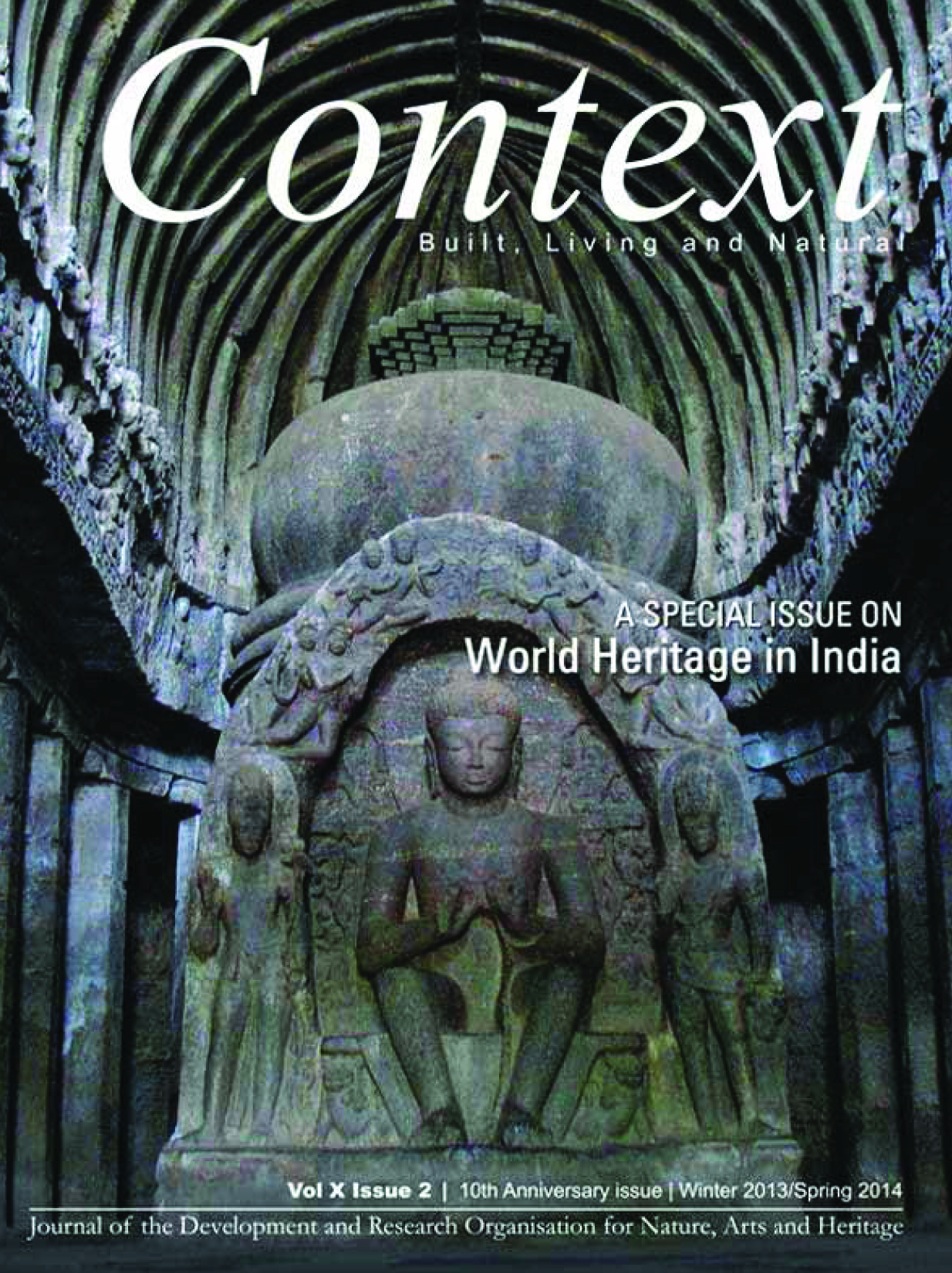Special Issue on World Heritage Sites in India: Volume X Issue 2
About the Volume
DRONAH presents this volume on World Heritage jointly with UNESCO New Delhi as a special 10th anniversary issue of ‘Context: Built, Living and Natural’. This issue covers a diverse range of opportunities and challenges for the World Heritage in India. At the same time, it brings forth India’s potential role in participating and contributing to the emerging trends in World Heritage.
There are varied perceptions about World Heritage Properties in India. While stakeholders and community at large recognise ‘World Heritage’ designation as the most coveted recognition of their cultural or natural heritage at a global level, they rarely comprehend the extent of commitment or management associated with conserving these sites. There is a significant increase in awareness about World Heritage, Operational Guidelines and other conventions in India in the last few years. The corpus of conservation professionals, heritage activists and non-governmental organisations in India, awareness programmes by the Archaeological Survey of India (ASI), support of the UNESCO New Delhi office and a proactive role played bythe Ministry of Culture are major factors contributing to a better understanding of World Heritage today. India is at an important juncture where professionals, stakeholders and communities are actively participating in dialogue and debate related to prescribed processes for World Heritage and inquiring into subsequent applications of these versus the ground realities in the country.
Clearly, there is a need for India to evolve its own standards and customized models for identifying and sustaining World Heritage properties. While we do have exemplary and well known socio-economic sustainability models for World Heritage sites such as the Humayun’s Tomb with Nizamuddin Basti renewal by Aga Khan Trust for Culture and ASI or the case of resolving tiger conflict with community management at Sunderbans Natural Heritage Site, there are several more examples of initiatives taken and challenges faced at ground level for World Heritage sites as well as properties on the Tentative List. In this issue, we have made an attempt to include a wide range of articles that cover preparation of the Tentative List, Nominations, Conservation, Management of World Heritage Sites and Capacity Building to give a perspective of World Heritage in India to our readers. Considering the vast pool of heritage resources and the rich repository of Indian culture, this is only a small glimpse of the larger picture that contributes to India’s World Heritage.
The Editorial Team
Contents
About the Volume
Foreword - Ravindra Singh
UNESCO in India - Shigeru AoyagiAspirations to be on World Heritage: Tentative List
Revision of India’s Tentative List of World Heritage Sites - Aruna Bagchee
Bridging the Gap: Historic Cities of India
Recommendation on Historic Urban Landscapes: Relevance in India
Jyoti Hosagrahar
Delhi’s Imperial Capital Cities: World Heritage nomination and the management of change
INTACH Delhi Chapter
Lessons learnt from the World Heritage City of Strasbourg
Minja Yang
Cultural Landscapes and Cultural Routes
Cultural Landscapes in India
Anand Kanitkar
The Pulsating Grand Trunk Road of Punjab: Connecting memories of civilizations
Gurmeet Rai and Ridhima Bajaj
Majuli Cultural Landscape: Management and World Heritage status
GSV Suryanarayana Murthy
Vital, Vast and Valued: The Western Ghats of India
Meena Venkataraman, Karthikeyan Vasudevan and Vinod B Mathur
The Hill Forts of Rajasthan as a Serial Nomination
Shikha Jain and Rima Hooja
Evolving models of Site Management in the Indian Subcontinent
Chhatrapati Shivaji Terminus, Mumbai: Managing a World Heritage Site
Vikas Dilawari
World Heritage and Archaeological Excavations: Fatehpur Sikri
K K Muhammed
Notions of Interpretation and Management: Cultural heritage of Taxila, Pakistan
Usman Ali
Paradigms for Structural Conservation: Observations and approaches for the Sun Temple, Konarak
Saptarshi Sanyal
The Great Living Chola Temples
Sathyabhama Badhreenath
Management of Living Urban World Heritage: Kathmandu Valley
Kai Weise
Managing World Heritage Properties in Madhya Pradesh
Vishakha Kawathekar
Jantar Mantar, Jaipur: Implementing the Management Plan
Salahudin Ahmed
City Development Planning in Mandu: Evolving city conservation and management strategy
Parul G Munjal and Palash Srivastava
The Role of Communities in Shaping the Management of World Heritage Sites
Rajendra Shende
Conventions and Capacity Building
Learning from UNESCO Conventions: Finding relevance for heritage conservation
Moe Chiba
Capacity Building for World Heritage Sites in India: Challenges and opportunities
Rohit Jigyasu
Developing Regional Strategy for Asia and the Pacific
Jian Zhou and Ping Kong
Heritage Album
Events and Conferences

